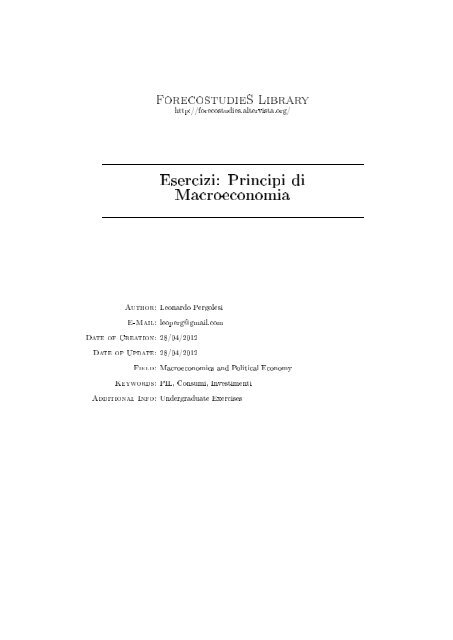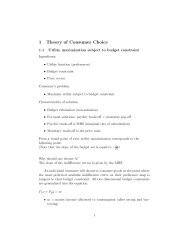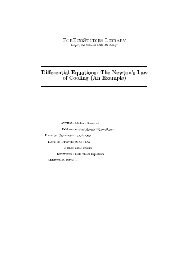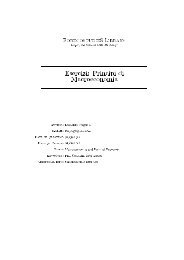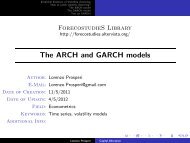Esercizi: Principi di Macroeconomia - ForEcoStudies - Altervista
Esercizi: Principi di Macroeconomia - ForEcoStudies - Altervista
Esercizi: Principi di Macroeconomia - ForEcoStudies - Altervista
You also want an ePaper? Increase the reach of your titles
YUMPU automatically turns print PDFs into web optimized ePapers that Google loves.
Forecostu<strong>di</strong>eS Library<br />
http://forecostu<strong>di</strong>es.altervista.org/<br />
<strong>Esercizi</strong>: <strong>Principi</strong> <strong>di</strong><br />
<strong>Macroeconomia</strong><br />
Author: Leonardo Pergolesi<br />
E-Mail: leoperg@gmail.com<br />
Date of Creation: 28/04/2012<br />
Date of Update: 28/04/2012<br />
Field: Macroeconomics and Political Economy<br />
Keywords: PIL, Consumi, Investimenti<br />
Ad<strong>di</strong>tional Info: Undergraduate Exercises
<strong>Principi</strong> <strong>di</strong> <strong>Macroeconomia</strong><br />
Problem Set n.1<br />
ESERCIZIO 1<br />
Si consideri la seguente tabella, riferita allo Stato Libero <strong>di</strong> Bananas e al 2009, in cui ogni posta è<br />
espressa in milioni <strong>di</strong> Bandollari correnti:<br />
• Consumi Aggregati 2601<br />
• Red<strong>di</strong>ti da Lavoro 2368<br />
• Spesa Pubblica per Beni e Servizi 815<br />
• Deprezzamento Capitale Fisico 437<br />
• Importazioni 449<br />
• Esportazioni 370<br />
• Profitti Aggregati 281<br />
• Investimenti Lor<strong>di</strong> 661<br />
• Trasferimenti Pubblici 487<br />
a. si calcoli il PIL Nominale<br />
b. definito il Prodotto Interno Netto come la <strong>di</strong>fferenza tra il PIL e<br />
l’ammortamento del capitale fisico: a quanto corrisponde, nel caso in esame?<br />
c. considerato che il PIL Reale per il 2009 è <strong>di</strong> 3585 milioni <strong>di</strong> Bandollari, si<br />
calcoli il Deflatore del PIL per il 2009.<br />
d. se il Deflatore del PIL per il 2008 è pari a 108.3, qual è il tasso <strong>di</strong> inflazione<br />
per il 2009?
a.<br />
Possiamo definire il PIL come misura aggregata <strong>di</strong><br />
C (consumption)<br />
I (investments)<br />
G (government)<br />
NX (net exports)<br />
Assumendo PIL=Y<br />
PIL NOMINALE<br />
Y= C + I + G + NX<br />
Y= 2601 + 661 + 815 + (370 - 449) = 3998<br />
Esportazioni - Importazioni<br />
Consumi<br />
aggregati<br />
Investimenti<br />
lor<strong>di</strong><br />
Spesa pubblica per beni e<br />
servizi<br />
b.<br />
Prodotto interno netto = PIN = PIL Nominale – Ammortamento capitale fisico = 3998 - 437 = 3561<br />
c.<br />
Il PIL Reale è la misura del PIL depurato degli effetti inflazionistici<br />
PIL Reale 2009 = 3585 milioni<br />
Il delatore del PIL è invece lo strumento che permette <strong>di</strong> depurare la crescita del PIL dall’aumento<br />
generalizzato dei prezzi (l’inflazione appunto)<br />
Deflatore PIL 2009:<br />
[(PIL nominale 2009)/(PIL reale 2009)]*100 = 111.52
d.<br />
Per il calcolo del tasso <strong>di</strong> inflazione si sfrutta un semplice passaggio matematico valido per il<br />
calcolo <strong>di</strong> qualsiasi tasso:<br />
[(Deflatore 2009) * (Deflatore 2008)] / (Deflatore 2008) * 100<br />
[(111.52) – (108.3)] / (108.3) * 100 = 2.97%<br />
ESERCIZIO 2<br />
Assumendo che i valori del PIL nominale e del PIL reale <strong>di</strong> Eurolan<strong>di</strong>a siano i seguenti:<br />
ANNO PIL Nominale PIL Reale<br />
2006 1200 € 1000 €<br />
2007 1360 € 1220 €<br />
2008 1600 € 1400 €<br />
2009 1500 € 1350 €<br />
Calcolate:<br />
a. il deflatore del PIL nei quattro anni;<br />
b. il tasso <strong>di</strong> inflazione nel 2009 e nel 2007;<br />
c. il tasso <strong>di</strong> inflazione me<strong>di</strong>a nei tre anni;<br />
d. il tasso <strong>di</strong> crescita del PIL reale nel 2009.<br />
a.<br />
Come descritto nell’esercizio precedente possiamo calcolare il deflatore del PIL nei vari anni come<br />
segue:<br />
Deflatore 2006 = [(PIL Nominale 2006)/(PIL Reale 2006)] * 100 = (1200/1000)*100 = 120<br />
Deflatore 2007 = [(PIL Nominale 2007)/(PIL Reale 2007)] * 100 = (1360/1220)*100 = 111.48<br />
Deflatore 2008 = [(PIL Nominale 2008)/(PIL Reale 2008)] * 100 = (1600/1400)*100 = 114.29<br />
Deflatore 2009 = [(PIL Nominale 2009)/(PIL Reale 2009)] * 100 = (1500/1350)*100 = 111.11
.<br />
Proce<strong>di</strong>amo come nel punto d) dell’esercizio precedente<br />
Tasso inflazione 2007 = [(Deflatore 2007) – (Deflatore 2006)] / (Deflatore 2006) * 100 =<br />
= (111.48 – 120) / 120 * 100 = -7.10%<br />
Tasso inflazione 2009 = [(Deflatore 2009) – (Deflatore 2008)] / (Deflatore 2008) * 100 =<br />
= (111.11 – 114.29) / 114.29 * 100 = -2.78%<br />
c.<br />
Per procedere al calcolo del tasso d’inflazione me<strong>di</strong>o nei tre anni necessitiamo del tasso relativo al<br />
2009, per cui:<br />
Tasso inflazione 2008 = [(Deflatore 2008) – (Deflatore 2007)] / (Deflatore 2007) * 100 =<br />
= (114.29 – 111.48) / 111.48 * 100 = 2.52%<br />
Tasso <strong>di</strong> inflazione me<strong>di</strong>o = (-7.10% +2.52% -2.78%) / 3 = -2.45%<br />
d.<br />
Tasso crescita PIL reale 2009 = (PIL Reale 2009 – PIL Reale 2008) / (PIL Reale 2008) * 100<br />
= (1350 – 1400) / 1400 * 100 = -3.57%<br />
ESERCIZIO 3<br />
Un’impresa deve decidere se investire in un progetto che costa 5000 euro, e che promette<br />
ren<strong>di</strong>menti annui <strong>di</strong> 2000 euro per tre anni, a partire dal prossimo.<br />
a. Se il tasso d’interesse <strong>di</strong> mercato corrente è pari al 15%, quale sarà la decisione dell’impresa?<br />
b. Cambierebbe qualcosa se il tasso scendesse all’8%?<br />
a.<br />
L’impresa investirà nel progetto solo se il valore attuale dei ren<strong>di</strong>menti annui sarà maggiore del<br />
costo dell’investimento.<br />
Per il calcolo del valore attuale si utilizza una semplice formula <strong>di</strong> matematica finanziaria per cui<br />
sappiamo che il valore attuale <strong>di</strong> una somma x <strong>di</strong>sponibile fra y anni con un tasso d’interesse <strong>di</strong><br />
mercato pari a z sarà:<br />
Valore attuale: X*(1+Z)^(-Y)<br />
Nel nostro caso dovremo sommare i valori attuali <strong>di</strong> ogni singolo ren<strong>di</strong>mento nei tre anni, pertanto:
Valore attuale = 2000*(1+0.15)^(-1) + 2000*(1+0.15)^(-2) + 2000*(1+0.15)^(-3)<br />
= 1739 + 1512.2 + 1315 = 4566.2 (approx.)<br />
4566.25000 L’impresa EFFETTUERA’ l’investimento<br />
ESERCIZIO 4<br />
Si consideri un’economia in cui i progetti <strong>di</strong> investimento <strong>di</strong>sponibili sono riassunti nella seguente<br />
tabella (tutti i progetti cominciano a rendere dall’anno successivo a quello in cui sono stati<br />
intrapresi):<br />
PROGETTO<br />
RENDIMENTO LONGEVITA’<br />
ANNUO<br />
(ANNI)<br />
ABC 5000 5 15000<br />
DEF 4500 6 15000<br />
GHI 4500 4 11000<br />
JKL 3500 5 11000<br />
MNO 3000 6 11000<br />
PQR 3000 5 10500<br />
STU 2000 5 7000<br />
VW 2000 4 5000<br />
XYZ 1000 8 5000<br />
COSTO<br />
Considerato un tasso <strong>di</strong> mercato del 20%, si calcoli:<br />
a. il Valore Attuale <strong>di</strong> ciascun progetto<br />
b. il valore degli investimenti aggregati<br />
c. il valore degli investimenti aggregati se il tasso scendesse al 10%.<br />
a.<br />
Proce<strong>di</strong>amo con lo stesso metodo <strong>di</strong> risoluzione usato nel precedente esercizio, per cui i valori<br />
attuali saranno:<br />
V.A. ABC = 14953,06<br />
V.A. DEF = 14964,80
V.A. GHI = 11649,31*<br />
V.A. JKL = 10467,14<br />
V.A. MNO = 10467,14<br />
V.A. PQR = 8971,84<br />
V.A. STU = 5981,22<br />
V.A. VW = 5177,47*<br />
V.A. XYZ = 3837,16<br />
* Si noti che solo il valore attuale <strong>di</strong> GHI e VW superano il costo relativo agli investimenti<br />
b.<br />
Per valore degli investimenti aggregati si intende il valore degli investimenti intrapresi.<br />
Solo due valori attuali superano i costi dei relativi investimenti (GHI e VW) per cui, il valore degli<br />
investimenti aggregati sarà:<br />
11000 + 5000 = 16000<br />
c.<br />
Usando la formula <strong>di</strong> finanziaria descritta nell’esercizio precedente possiamo calcolare il valore<br />
attuale <strong>di</strong> ogni singolo investimento con un tasso al 10%, per cui:<br />
V.A. ABC = 18953,53<br />
V.A. DEF = 19598,67<br />
V.A. GHI = 14264,39<br />
V.A. JKL = 13267,75<br />
V.A. MNO = 13065,78<br />
V.A. PQR = 11372,36<br />
V.A. STU = 7581,57<br />
V.A. VW = 6339,73<br />
V.A. XYZ = 5334,93<br />
Notiamo che con il tasso d’interesse al 10% l’impresa effettuerà tutti gli investimenti.<br />
Il valore degli investimenti aggregati sarà a questo punto la somma dei costi <strong>di</strong> ogni progetto: 90500


